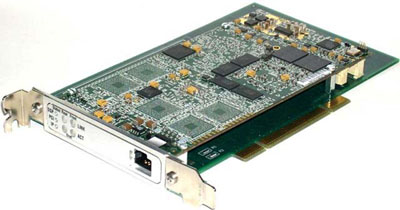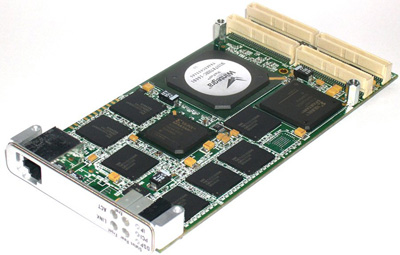Asterisk VoIP Card for IP PBX Systems
VoIP PCI/PCIe Card for Voice Codec, transcoding, Echo Cancellation, and VQE for Open Source VoIP Systems

|
| SigC5561 VoIP PCI card for Asterisk IP PBX server |

|
| SigC5561 card without PCI adapter, view of front bezel and bottom side. Configurable from 1 to 12 high-density Texas Inst TNETV3010 VoIP chips. Each chip has six (6) cores capable of 32 channels each of carrier grade VoIP, including echo can and voice codec |
- Overview
- VoIP Overview
- VoIP Feature Summary
- PSTN Interface Options
- Software Support
- Channel Capacity table
- Simultaneous Capacity table
- Specifications
- Frequently Asked Questions
- Host Media Processing
- Network Configuration Examples
- Server Configuration Examples
- SigIMS IMS Platform
Overview
The SigC5561 PCI/PCIe card utilizes Texas Instruments / Telogy TNETV3010 DSP devices to provide a high-density, low-cost packetization engine for Asterisk IP PBX and open source VoIP systems. The TNETV3010 device yields a high ratio of channel capacity to cost and board space, providing up to 192 channels per device including full 128 msec echo cancellation, multiple voice codecs (see list below), G.711.1 packet loss concealment, VAD, CNG, DTMF functions and RFC 2833 relay, jitter buffer, and more. The SigC5561 card complies with HMP (Host Media Processing) architecture and allows transfer of both tdM and packet data over PCI/PCIe bus, providing a hardware engine for PC-based media gateway, softswitch, and transcoding server applications based on open source VoIP software. Channel capacity scales from 192 to 2304 G.711 (PCM voice), 96 to 1152 G.729AB or iLBC, and 72 to 864 G.723 or GSM-AMR channels. The SigC5561 board may also be used in ATCA, cPCI, VME, and other infrastructure platforms. Click here for more information about non-desktop PC configurations of the SigC5561 card. SigC5561 card highlights include:- up to 2304 G.711 channels, 1152 G.729AB or iLBC channels, and/or 864 G.723 or GSM-AMR channels
- configurable echo can, VoIP and transcoding operation
- each VoIP channel independently configurable for echo can, voice codec, and other parameters
- WinPath 7x7 network processor and direct GbE and 10/100 network RJ-45 connections
VoIP Overview
In a typical VoIP application, the SigC5561 card processes tdM channels of 64 kbps PCM (G711) voice, fax or data traffic. Voice data is optionally compressed via G729AB, G723, GSM-AMR, EVRC, iLBC, or other Lbr codec. In addition, the SigC5561 card provides RTP, RTCP, or T.38 packetization of voice and fax data, and a comprehensive range of voice and data telephony functions. In a typical transcoding application, the SigC5561 card transcodes between one type of Lbr codec and another, for example between G729AB and G723, or G729AB and GSM-AMR, using embedded logic on the board to allow internal PCM loopback and framesize adjustment. Mixed VoIP and transcoding applications are supported. For advanced applications, an optional WinPath network processor provides packet formatting, segmentation, reassembly, and routing functions directly on the SigC5561 card, without host intervention, including direct GbE or 10/100 interfaces to RJ-45 connectors.PSTN Interface Options
There are three (3) ways to interface PSTN lines, also known as tdM or PCM data, to the SigC5561 card:- Separate multi-FSX/FXO, multi-T1/E1 or T3 PCI card(s). In this case, tdM data is transported on the PCI bus, between cards. Providers of T1/E1 and T3 cards include Digium, Sangoma, SBE, and more. This method is the least expensive and most flexible, but experiments show that reliable operation is limited to about 500 or so tdM channels over the PCI/PCIe bus on 32-bit PCI/PCIe motherboards.
- Unified multi-T1/E1 or T3 card. In this case, the SigC5561 and another PMC form-factor card are combined on a dual site PCI carrier card, which allows tdM data to move between the two cards without PCI bus interaction. A typical dual carrier card configuration would combine a SigC5561 card and a wanT3 channelized DS3 card. The dual carrier method allows higher channel capacities due to direct inter-card tdM communication, free from impact of system activities involving the PCI/PCIe bus. tdM channel capacities up to 2048 full-duplex channels are possible per SigC5561 card.
- tdMoIP protocol. tdM-over-IP protocol, also referred to as CESoPSN, may be used. In this case, tdM data is transported on the GbE interface to the SigC5561 card, where it is "interworked" by the WinPath network processor into tdM format data and routed to the tdM side of the DSP farm. tdM channel capacities up to 2304 full-duplex channels are possible per SigC5561 card.
VoIP Feature Summary
Below are VoIP features included with all configurations of the SigC5561 card.| Voice Compression (CODEC) |
G.711 (64 kbps m-law or A-law) G.711.1 (Appendix A) Packet Loss Concealment G.722 wideband (48, 56, 64 kbps) G.723.1 (24, 40 kbps) G.723.1A G.726 ADPCM (16, 24, 32, 40 kbps) G.727 ADPCM G.728 (16 kbps) G.729 (8 kbps) G.729AB (8 kbps) G.729D (6.4 kbps) G.729E (11.8 kbps) GSM FR, GSM EFR, GSM AMR EVRC SMV iLBC QCELP13 FAX T38U CID CONF |
| Echo Cancellation |
G.165 and G.168 64 msec nominal. Up to 128 msec with multiple reflection cancellations; includes Telogy proprietary enhancements |
| Jitter Buffer | Packet playout unit; Telogy packet-loss mitigation options |
| Silence Suppression |
VAD, CNG, Telogy proprietary G.723.1A G.729AB GSM FR GSM EFR |
| Fax Relay / Pass-Thru: |
T.38 TCP/IP FRF.11 AAL2 I.366.2 V.17 @ 7.2, 9.6, 12, 14.4 kbps V.27ter @ 2.4, 4.8 kbps V.29 @ 7.2, 9.6 kbps T.30 |
| Modem Relay / Pass-Thru: |
V.92 V.90 V.34 V.32bis V.22bis V.21 V.23 Bell 212, 103 V.42 MNP 2-4, V.44 MNP 5 Modem transparency: auto-switch from G.7xx to G.711 on fax or modem detection |
| ISDN |
Sync-mode PPP, HDLC framed PPP V.110 56k rate adaptation |
|
VoIP Standards Compliance |
RTP RTCP per RFC 1889/1890/2508 UDP/IP header |
| In-Band Signaling / Call Processing | DTMF, MF R1, MF R2, MFC, SS7 COT, SF, Call Progress for T1 CAS |
| Out-of-Band Signaling / Call Processing | DTMF Relay (RFC 2833) |
| Rx, Tx Gain Control | Programmable ±31 dB |
| tdM Protocols |
CESoPSN (tdMoIP) H.110 subset (also known as CTbus) |
VoATM Standards Compliance |
AAL0 (raw cell) AAL1 AAL2 I.366.2 |
| Network Packet Switching | Example: G.729AB / RTP G.726 / AAL2 |
| Packet Aggregation and Processing |
Running default Control Path Software (CPS) and Data Path Software (DPS) builds, the WinPath 747 or 787 Communications and Network Processor provides:
|
Software Support
Asterisk software support includes Linux drivers and install scripts. For open source VoIP and application-specific programming, DirectdSP software is available that allows host C/C++ programming interface to the card. WinXP and Win9x drivers and Win version of DirectdSP software are also available. The SigC5561 card may also be used with applications other than Asterisk; the C5561 card driver and API fully support user-defined application software.Channel Capacity table
The table below gives channel capacities for available configurations of the SigC5561 card, including 2 DSPs, 7 DSPs, and 12 DSPs. Note that all channels include 64 msec echo cancellation.| Description | Codec | 2 DSPs | 7 DSPs | 12 DSPs |
|---|---|---|---|---|
| ITU Codecs | G.729 G.723 G.726 G.711 G.711 App 1 Fax, T38 |
192 144 192 384 336 384 |
672 504 672 1344 1176 1176 |
1152 864 1152 2304 2016 2016 |
GSM Codecs | GSM FR GSM EFR GSM AMR |
144 144 144 |
504 504 504 |
864 864 864 |
CDMA Codecs | EVRC SMV QCELP13 |
96 96 96 |
336 336 336 |
576 576 576 |
Cable Codecs | iLBC G728 G729E Fax, T38 |
96 96 96 192 |
336 336 336 672 |
576 576 576 1152 |
Simultaneous Call Capacity table
The table below gives IP-to-IP simultaneous call figures assuming one call leg is G.711. "IP-to-IP" is typically referred to as transcoding. Note that G711 leg includes 64 msec echo cancellation, if required by the application. Download Reference GuideSpecifications
Below are specifications for the SigC5561 card. All specifications are subject to change.| Dimensions | 4.3 x 7.44 x 0.5" (109 x 189 x 12.7 mm) Length measured from surface of back-plate, height measured from surface of motherboard, width less than single slot | |
| DSP Farm |
Up to 12 Texas Instruments TNETV3010 devices with Premium Carrier Grade Telogy Software; includes indemnification of essential patents for conformance & interoperability |
|
| Network Processor (NPU) | Wintegra WinPath 747 or 787 Access Packet Processor | |
| PCI Bus Interface | 32-bit, 33 MHz PCI; 3.3V signaling with passive adapter, 5V signaling with active adapter | PCIe Bus Interface | 4x or higher, up to 133 MHz clock rate, differential signaling per PICMG v1.3, active adapter including PCIe-to-PCI bridge |
| Power Consumption |
15W in 2 DSP configuration 16W in 7 DSP configuration 23W in 12 DSP configuration** |
|
| Temperature | Operating: | 0șC to 55șC (airflow >200 LFM) |
| Storage: | -40șC to 85șC | |
| Humidity | Operating: | 10 to 90% non-condensing |
| 5 to 95% non-condensing | ||
| Designed to Meet |
FCC Part 15 Subpart B EN55022 EN55024 UL60950 3rd edition UL60950 3rd edition |
|



